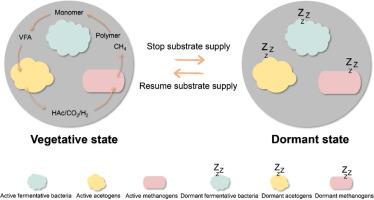Science of the Total Environment ( IF 8.2 ) Pub Date : 2021-10-16 , DOI: 10.1016/j.scitotenv.2021.151024 Wenda Chen 1 , Yihao Jin 1 , Dongdong Xu 1 , Wenji Li 1 , Chao Pan 1 , Yiyu Li 1 , Da Kang 1 , Meng Zhang 2 , Zhuo Zeng 3 , Shengdao Shan 4 , Ping Zheng 1

|
Anaerobic granular sludge (AnGS) is the core of anaerobic granular sludge bed system. In this study, the effect and its mechanism of stopping substrate supply on function of AnGS were investigated. The cutoff of exogenous substrate supply triggered AnGS to enter the dormant state. Some methanization microorganisms sporulated. The number and activity of methanization microorganisms based on 16S rDNA and 16S rRNA/16S rDNA ratio declined and stayed at 45.5% and 0.06% (bacteria), 48.7% and 0.39% (archaea) of the initial vegetative value, respectively. The resuming of exogenous substrate supply promoted AnGS to restore the vegetative state. The spores disappeared. The specific methanization activity of AnGS returned to the original level of 35.82 mL-CH4/g-VSS·d, but the delay time for gas production (DTGS) was prolonged from 9.54 to 18.04 h (0–132 d). The dormancy of methanization microorganisms was the main cause for the fluctuation of apparent function and the stability of intrinsic function of AnGS under starvation stress. The dormancy stabilized the structure and sustained the methanization community of AnGS via the reduction of EPS (structure binder/energy reserve) consumption.
中文翻译:

厌氧颗粒污泥的潜在功能调节剂:饥饿和休眠
厌氧颗粒污泥(AnGS)是厌氧颗粒污泥床系统的核心。在本研究中,研究了停止底物供应对 AnGS 功能的影响及其机制。外源底物供应的中断触发 AnGS 进入休眠状态。一些甲烷化微生物形成孢子。基于 16S rDNA 和 16S rRNA/16S rDNA 比率的甲烷化微生物的数量和活性下降,分别保持在初始营养值的 45.5% 和 0.06%(细菌)、48.7% 和 0.39%(古细菌)。外源底物供应的恢复促进了 AnGS 恢复植物状态。孢子消失了。AnGS的比甲烷化活性恢复到原来的35.82 mL-CH 4 水平/g-VSS·d,但产气延迟时间(DTGS)从 9.54 小时延长至 18.04 小时(0-132 天)。甲烷化微生物的休眠是造成饥饿胁迫下AngS表观功能波动和内在功能稳定的主要原因。休眠通过减少EPS(结构粘合剂/能量储备)消耗来稳定结构并维持AngS的甲烷化群落。







































 京公网安备 11010802027423号
京公网安备 11010802027423号